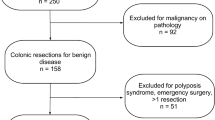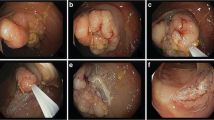Abstract
PURPOSE: Colonoscopic polypectomy is the preferred technique to remove the majority of polyps. The authors evaluate feasibility, safety, and the effectiveness of endoscopic treatment of colorectal benign-appearing polyps equal to or larger than 3 cm. METHODS: Ninety-seven patients with 104 giant polyps underwent polypectomy within a nine-year period. The majority of these procedures were performed on an outpatient basis, all on unsedated patients. Gross appearance, size, location, histologic characteristics, synchronous lesions, modality, and adequacy of removal of giant polyps were analyzed. The follow-up was achieved in 89 percent of patients during a period ranging from 6 to 96 months (median, 38). RESULTS: Of the 104 removed polyps, 75 (72 percent) were adenomatous, 2 (2 percent) were hyperplastic, and 27 (26 percent) were malignant polyps. Six patients had more than one giant polyp. Several additional smaller polyps were found in 52 patients and a synchronous cancer in 4. Twenty-one (20 percent) giant polyps were equal to or larger than 4 cm. Forty-nine were pedunculated, 20 were short-stalked, and 35 were sessile. Sixty-one polyps were excised in one piece, and forty-three were excised using a piecemeal technique. Only four complications (3.8 percent) were recorded; all cases were treated endoscopically. Fifty-eight (75 percent) adenomas and eighteen (67 percent) malignant polyps were completely excised. Surgery was performed in 7 of 27 patients (27 percent) with malignant polyps, where there was a doubtful, infiltrated margin or poorly differentiated cancer. Post-polypectomy surveillance permitted the detection and treatment of 25 metachronous or recurrent polyps and a metachronous cancer. CONCLUSIONS: This study shows that polypectomy of giant colorectal polyps, performed by an expert endoscopist, is feasible, effective, and safe, even on an outpatient basis. The authors confirm that malignant polyps with incomplete excision, lymphovascular invasion, and poor differentiation require bowel resection. Post-polypectomy surveillance is useful for all patients who have undergone colonoscopic resection of giant adenomatous or malignant polyps.
Similar content being viewed by others
References
Bedogni G, Bertoni G, Ricci E,et al. Colonoscopic excision of large and giant colorectal polyps: technical implications and results over eight years. Dis Colon Rectum 1986;29:831–5.
Gyorffy EJ, Amontree JS, Fenoglio-Preiser CM, Gogel HK, Blessing LD. Large colorectal polyps: colonoscopy, pathology, and management. Am J Gastroenterol 1989;84:898–905.
Kanamori T, Itoh M, Yokoyama Y, Tsuchida K. Injection-incision-assisted snare resection of large colorectal polyps. Gastrointest Endosc 1996;43:189–95.
Bardan E, Bat L, Melzer E, Shemesh E, Bar-Meir S. Colonoscopic resection of large colonic polyps—a prospective study. Isr J Med Sci 1997;33:777–80.
Binmoeller KF, Bohnacker S, Seifert H, Thonke F, Valdeyar H, Soehendra N. Endoscopic snare excision of “giant” colorectal polyps. Gastrointest Endosc 1996;43:183–8.
Walsh RM, Ackroid FW, Shellito PC. Endoscopic resection of large sessile colorectal polyps. Gastrointest Endosc 1992;38:303–9.
Stulc JP, Petrelli NJ, Herrera L, Mittelman A. Colorectal villous adenomas equal to or greater than four centimeters. Ann Surg 1988;207:65–71.
Muto T, Bussey HJ, Morson BC. The evolution of cancer of the colon and rectum. Cancer 1975;36:2251–70.
Morson BC. Genesis of colorectal cancer. Clin Gastroenterol 1976;5:505–25.
Nusko G, Mansmann U, Partzsch U,et al. Invasive carcinoma in colorectal adenomas: multivariate analysis of patient and adenoma characteristics. Endoscopy 1997;29:626–31.
Netzer P, Binek J, Hammer B, Lange J, Schmassmann A. Significance of histologic criteria for the management of patients with malignant colorectal polyps and polypectomy. Scand J Gastroenterol 1997;32:910–6.
Shinya H, Wolff WI. Morphology, anatomic distribution, and cancer potential of colonic polyps: an analysis of 7000 polyps endoscopically removed. Ann Surg 1979;190:679–83.
Morson BC, Whiteway JE, Jones EA, Macrae FA, Williams CB. Histopathology and prognosis of malignant colorectal polyps treated by endoscopic polypectomy. Gut 1984;25:437–44.
Rosen L, Bub DS, Reed JF III, Nastasee SA, Hemorrhage following colonoscopic polypectomy. Dis Colon Rectum 1993;36:1126–31.
Waye JD. How big is too big? Gastrointest Endosc 1996;43: 256–7.
Kyzer S, Bégin LR, Gordon PH, Mitmaker B. The care of patients with colorectal polyps that contain invasive adenocarcinoma. Endoscopic polypectomy or colectomy? Cancer 1992;70:2044–50.
Neugut AI, Jacobson JS, Ahsan H,et al. Incidence and recurrence rates of colorectal adenomas: a prospective study. Gastroenterology 1995;108:402–8.
Nozaki R, Takagi K, Takano M, Miyata M. Clinical investigation of colorectal cancer detected by follow-up colonoscopy after endoscopic polypectomy. Dis Colon Rectum 1997;40(Suppl):S16–22.
Author information
Authors and Affiliations
Additional information
Supported by the University of Parma, Parma, Italy.
About this article
Cite this article
Dell'Abate, P., Iosca, A., Galimberti, A. et al. Endoscopic treatment of colorectal benign-appearing lesions 3 cm or larger. Dis Colon Rectum 44, 112–118 (2001). https://doi.org/10.1007/BF02234832
Issue Date:
DOI: https://doi.org/10.1007/BF02234832




